|
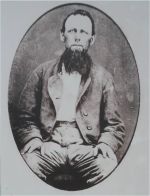
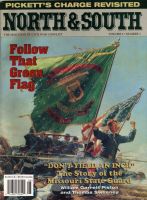
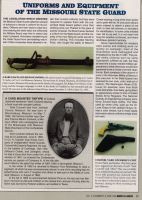
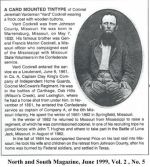
Wall Plaque at Fort Davidson Museum,
Pilot Knob, Missouri
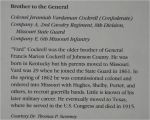
Texas Representative Jeremiah Cockrell
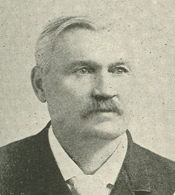
|
Jeremiah Vardaman Cockrell
(May 7, 1832 - March 18, 1915), (brother of Francis Marion Cockrell), was a Confederate officer and an American politician from the state of Texas. He served as a United States Congressmen from Texas for two terms.
Jeremiah Cockrell was born in Warrensburg, Johnson County, Missouri to Joseph and Nancy Cockrell, and was a grandson to Reverend Simon and Mary Magdalena (Vardeman) Cockrell. His younger brother was Francis Marion Cockrell, who was also a Confederate officer and subsequently a United States Senator from Missouri from 1875 to 1905. Jeremiah attended the common schools and Chapel Hill College, Lafayette County, Missouri.
In 1848 he made a trip to New Mexico, and in 1849 he went overland to California, where he settled at McKinney’s Ranch on the Bear River and for two years engaged in mining and merchandising.
He returned to Missouri in 1852, married Maranda J. Douglass, and began farming, to study law and was listed as a minister.
In 1861 he entered the Confederate Army as a lieutenant and served throughout the Civil War, attaining the rank of colonel. In 1862 he was nominally in command of Confederate forces at the battle of Lone Jack, Missouri. In 1864, perhaps during the Missouri campaign of Major General Sterling Price, he was so seriously wounded that he was not able to engage in active service again.
At the close of the war he settled in Sherman, Grayson County, Texas, and engaged in the practice of law and became a chief justice of Grayson County in 1872. He became a delegate to the Democratic State conventions in 1878 and 1880 and moved to Jones County where he was appointed judge of the thirty-ninth judicial district court in 1885, to which position he was elected in 1886 and reelected in 1890. He was elected as a Democrat to the Fifty-third and Fifty-fourth Congresses (March 4, 1893-March 3, 1897) but was not a candidate for re-nomination in 1896.
He engaged in farming and stock raising in Abilene, Jones County, Texas where he died March 18, 1915 with interment in the Masonic Cemetery.
Battle of Lone Jack, Missouri August 15-16, 1862
Background
During the summer of 1862 many Confederate and
Missouri State Guard recruiters were dispatched north from Arkansas into
Missouri to replenish the depleted ranks of the Trans-Mississippi
Confederacy. In Western/West-Central Missouri these included then
Captain Jo Shelby, Colonel Vard Cockrell, Colonel John T. Coffee, Upton
Hays, John Charles Tracy, John T. Hughes, and DeWitt C. Hunter. Most of
these commands were working independently and there was no clear sense
of seniority yet established. On August 11 the Federal commander General
John Schofield was stunned to learn that Independence, Missouri had
fallen to a combined force of Colonel John T. Hughes, William Quantrill,
Gideon W. Thompson and Upton Hays. Schofield ordered General James
Totten to concentrate his forces to deal with the threat.
Skirmish
On August 15, 1862 Union Major Emory S. Foster,
under orders from Totten, led a 740-man combined force from Lexington to
Lone Jack. Other forces were dispatched from Kansas under General James
G. Blunt (2,500 men) and Missouri under General Fitz Henry Warren (600
men), but they would not arrive in time for the engagement. Upon
reaching the Lone Jack area, Foster received intelligence that 1,600
Rebels under Col. Coffee and Lt. Col. Tracy were camped near town and
prepared to attack them. The estimate of the Rebel command was revised
down to only 800 and at about 11:00 p.m., Foster and his men attacked
the Confederate camp and dispersed the enemy. The firing of his cannon
during this brief skirmish proved to be Foster's undoing, for it alerted
Colonel Vard Cockrell and other rebel commands in the area of Foster's
position and intent to fight. Foster's men returned to town to rest
along the main street, having spent several days in the saddle. Colonel
Cockrell conferred with Upton Hays, Lt. Col. Sydney D. Jackman, and
DeWitt C. Hunter and determined to give battle the next morning with the
intent of overwhelming the much smaller Union force.
Battle
Cockrell's plan was to clandestinely deploy Hunter, Jackman and Tracy's forces in a field to the west of town well before sunrise on August 16 and await the opening of the fight. Hays was to initiate the battle with a mounted attack from the north as daylight approached, whereupon the others would launch a surprise flank attack. Hays did not attack as early as planned, instead reconnoitering the other commands before advancing. As daylight appeared Foster's pickets became aware of Hays' advance. This gave Foster's men a brief opportunity to deploy, spoiling the element of surprise.
With sunrise exposing them while awaiting Hays' tardy advance, Jackman, Hunter, and Tracy attacked but were held in check. Hays then performed a dismounted attack from the North. Together his force and Tracy's crumpled the Union right flank, forcing the 7th Missouri Cavalry (commanded by Captain Milton H. Brawner) back onto the artillery. The cannoneers now began a desperate fight. Union Captain Long's 2nd Battalion Missouri State Militia Cavalry concealed behind a hedge row of Osage orange trees poured a crossfire on the Confederates, temporarily repulsing them.
On the other side of the field Hunter's force was stalled by three companies of Captain Plumb's 6th Missouri State Militia Cavalry. A mounted force (possibly Coffee's) approached on Hunter's flank and he mistook them for Federals. The mounted men attacked but were surprised and repulsed by fire from Capt. Slocum's company of the 7th Missouri State Militia Cavalry behind another Osage orange hedge. Hunter, now short of ammunition, abandoned the field for the ammunition train, exposing Jackman's flank. Jackman was also short of ammunition and retired as well.
Tracy's and Hays' commands renewed their attack to the north, eventually displacing the Indiana artillerists. With no remaining Confederate threat to the south, Captain Plumb now counterattacked to the north, reclaiming the artillery. Jackman and Hunter's resupplied men then returned to the field. Hays attempted to counter attack but a counter-charge by Plumb forced him to retreat. Much of the fighting then devolved into a war of attrition between Confederates on the western side of the street, Union men on the right with their artillery in the middle. The artillerists were soon routed and the guns changed hands several times. Foster recaptured the guns a final time, being severely wounded himself in the process.
After five hours of fighting and the loss of Foster, rebel Col. Coffee and his 800 men reappeared north of town causing Foster’s successor, Capt. Milton H. Brawner, to order a retreat. The men left the field in good order and returned to Lexington. The cannon were hastily spiked or disabled and hidden before the Federals departed. The Confederates secured a victory, but the approach of Union forces including Blunt and Fitz Henry Warren forced the Rebels to withdraw on August 17. General Fitz Warren occupied the town that day.
Foster was later criticized for attacking on the first day while being outnumbered and for not awaiting reinforcement. However, Fitz Warren's command did not arrive until two days later, and Blunt's three days after Foster arrived. The Federals fought more vigorously because many believed Quantrill's raiders were present and would be brutal to prisoners.
Casualties & aftermath
Federal Capt. Brawner reported Union losses as 43 killed, 154 wounded, and 75 missing/captured, a casualty rate of 34 percent and this was almost certainly too low. Rebel Colonel Hunter reported burying 119 Federals and 47 Rebels, but the true losses are unknown. Excluded from Hunter's total were an unknown number of dead Confederates claimed by their friends and families for burial elsewhere. [9] A recent roll call list of Federals killed at the action as compiled in service records by Wayne Schnetzer reveals 65 killed and at least 29 who later died from wounds received at Lone Jack. The list of known Confederate participation and deaths is less complete, but at least 55 names are listed as killed, with at least 4 others later succumbing to their wounds.
Colonel Cockrell succeeded in locating the two cannon and removed them from the field and back to Arkansas. One was later credited with firing the shot that disabled the Queen City on the White River. Because they were in possession of the field, the Confederate recruits gained a substantial quantity of needed firearms. As many as half of the recruits were initially unarmed.
This was the only Civil War battle fought by future Secretary of War and U.S. Senator Stephen B. Elkins. Elkins was to say that he disgusted of war after what he witnessed in the battle.
Kansas City was the only place in Missouri then that had Union
people in it, at least in that part of Missouri. The colonel of the
regiment to which I became attached was Kersey Coates, who built the big
opera house and hotel in Kansas City. I was in continual danger of being
killed, and was marked by Quantrill's men as a renegade who was to be
shot as soon as taken. I saw one battle while in the service, that of
Lone Jack, and a most awful battle it was. Col. Emory S. Foster had a
Union regiment which was attacked by the brother of Senator Cockrell,
but Foster thought the Confederates were the guerrilla hands who raised
the black flag, and never gave any quarter. So he refused to surrender,
and every one of his officers was picked off. The guerrillas were
victorious. I went over the battlefield afterward, the blood, the cries
for water and death, the naked bodies stripped of their clothing, the
dead horses which served for ramparts, gave me a disgust for war, which
makes it seem strange that I am here at the head of the war department
of this great government.
Cole Younger
Most of Quantrill's Raiders were still in Independence, Missouri
looting after victory in the First Battle of Independence, however
18-year-old Cole Younger was present at Lone Jack riding along the front
lines to supply the troops.
The wounded Foster was briefly captured by the Confederates and placed in a cabin and was threatened with execution. Younger physically pushed his would-be assailant out of the cabin.
Another act of Younger gallantry was an encounter shortly after the battle was when he warned Union Major Warren C. Bronaugh against riding into Confederate lines.
When Younger was captured in the James-Younger Gang robbery of the Northfield, Minnesota First National Bank, Elkins, Bronaugh and Foster (who was then editor of the St. Louis Evening Journal) were to argue for clemency for Younger.
Order of battle
Union: Major Emory S. Foster
7th Missouri Cavalry (companies A,C,E,F,I) -- Capt. Milton H. Brawner, 265 men
6th Missouri State Militia Cavalry (Companies A,B,E) -- Capt. W. Plumb, 149 men
8th Missouri State Militia Cavalry (Companies F,H) -- 140 men
2nd Battalion Missouri State Cavalry (Companies A,C,F) -- Capt. J.H. Long, 81 men
7th Missouri State Militia Cavalry (Company H) -- Capt. E. Slocum, 69 men
3rd Indiana Artillery (1 section of two 12-pounder James Rifles) -- Lt. J.S. Develin/Sgt. James M. Scott, 36 men
Union order of battle, officers and strengths from Banasik's Embattled Arkansas.
Confederate:
Colonel Jeremiah "Vard" Cockrell
Hays Regiment recruits -- Col. Upton Hays, 400 men
Hunter's Regiment recruits -- Col. DeWitt C. Hunter, 750 men
Jackman's Regiment recruits -- Lt. Col. Syndey Drake Jackman, 450 men
Tracy's Regiment recruits -- Lt. Col. John Charles Tracy, 350 men
Coffee's Regiment recruits -- Col. John T. Coffee, 800 men (arrived at end of action)
Confederate order of battle from "Shot All to Pieces" by Matt Matthews and Kip Lindberg.
Biography researched by David Vardiman |
Links:
FactsTexas Representative 1893-1897
|






